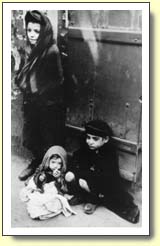by Ruth Bobb
This picture is about the kids from the ghetto who are starving. The kids are very skinny and about to die.Http://www.ushmn.org/outreach.
I am informing the adults in Poland and around the world so they could see how life was very harsh in the ghettos created by the Nazis. People need to help the Jews in the ghettos with food and medical attention.
The term ghetto originated from the name of the one in Venice established in 1516. Now ghettos are in city districts where the Nazis forced the Jewish population to live a miserable and harsh life. Ghettos isolated Jews by separating Jewish communities from the non-Jewish. The Nazis established over 400 ghettos in Poland.
Walls,or barbed wire fences, or gates closed off most ghettos. Ghettos are extremely crowed and unsanitary. The inhabitants suffer from starvation and severe winter weather.
Warsaw has the largest ghetto in Poland where approximately 450,000 Jews are crowed into an area of 1.3 square miles. Other major ghettos are in Lodz, Krakow, Bialoystok, Lou, Dublin, Uilna, Kobrou, Czestochowa and Minks.
Life in the ghetto was very harsh. The most important thing that was in common was over-crowding. One apartment might have several families living in it. Life is getting harder: plumbing breaks down, and human waste is thrown in the street along with the garbage.
Disease began to spread rapidly. People can only purchase small amounts of bread, potatoes, and fat. Few Jews had money so they trade for foods. Others are forced to beg or steal to survive. During winter, many people lack adequate clothing. A lot of people died of hunger and exposure because of cold. Some Jews killed themselves to escape their hopeless life.
The Nazis ordered Jews to wear identifying badges or armbands and also required many Jews to perform forced labor for the German Reich. Nazis appointed a Jewish council and also Jewish police to administer the daily life of living in the ghetto.
Illegal activities, such as smuggling food or weapons, joining youth movements, or attending cultural events without a approval would be punished
Many orphaned children are taking care of their younger siblings. The orphans often live on the streets, begging for food. Many orphans froze to death in the winter.
In the Warsaw Ghetto sometimes people help smuggle food to their families and friends by crawling through the ghetto wall. If they got caught they are punished badly. Many young people try to continue their education by attending school. Classes are held secretly in the defiance of the Nazis. Jews learn to hide books under their clothes to avoid being caught.
Even though life is harsh in the ghetto children did not stop playing with toys. Some had beloved toys or trucks they brought into the ghetto with them. Children also made toys using whatever bits of cloth and wood they could find. They also turned the top of empty cigarette boxes into to playing cards.
Abraham Lewents, a resident of the Ghetto in Warsaw, Poland, described conditions: " People were lying on the street and dying." (Life) Little children went around begging and every day you woke up in the morning you see somebody laying dead, covered with newspaper or with any kind of blankets they found. People were carried in little wagons. They use them to bring the bodies down to the cemetery and bury them in mass graves. Every day thousands and thousands died of malnutrition. The words that he heard everyday were. " It’s your luck if you don’t have it, you die" (Life)
Another witnesses Paulette Lewis went to the Lodz ghetto. Paulette Lewis describes the condition as very harsh. In the wintertime she wore light jacket; then she wore one on top of the other. Paulette had two different pairs of shoes. The only clothes she had was a jacket, skirt, some blouse and a couple of dresses. Her mother had leather and she took it to the shoemaker and made a pair of shoes out of it. She paid the shoemaker by giving him left over leather. No one wore pants in those days. They only wore stockings. If they rip they would tape it up.
The way they took showers was with bowls and you put some water in it, and they would bath with snow if they ran out of water. They brush their teeth with no toothpaste. People's teeth started to decay and she lost fillings. Lice was in common. If you wore sweater about two weeks straight when turned it inside out in the seam you would see a white spot and those were lice eggs.
Life in the ghetto is very harsh and some people survive and some don’t. A lot of people are loosing loved ones. Adults please donate food to all in the ghetto and money for other necessities.
Bibliography
Book
Wiesel , Elie. Night. NY. Bantam:1960
Professional website
"Life in the Ghetto," Outreach, USHMM, May 2002
Encyclopedia
"Ghetto" Britannica Encyclopedia 5th ed.1995.
use fonts colors and images very effectively.
cite sources in correct form.
use the Internet to do research.
present audience and purpose well
create her own hotlinks
use quotes
Student needs help with:
writing more unified paragraphs



